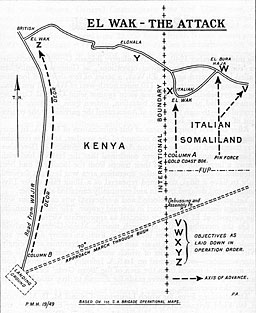
6
Raid on El Wak
By mid-December 1940, 1st S.A. Infantry Brigade Group was occupied in 'the first of the cutting-out operations', as General Cunningham called it. Directed against El Wak, a series of five defended localities straddling the frontier some 110 miles north-west of Wajir, it was a raid by an overwhelmingly superior force against what General Cunningham recorded as one enemy battalion, sixteen guns and some Banda Irregulars1--though the Duke of Aosta rated the garrison at the equivalent of about three battalions.
After the first postponement of this culmination of 1st S.A. Infantry Brigade Group's training, on account of the weather, another rehearsal was completed in the area about Arbo by the beginning of December. Then a reconnaissance in force confirmed that the Italians had withdrawn a large proportion of their troops from the locality it had been intended to raid. An alternative operation area was brought forward, only to have a final, combined rehearsal of a Buna raid under Divisional control delayed by rain and eventually cancelled altogether.
Yet another area was selected and a rehearsal was carried out with all troops destined to take part in the raid proper. The enemy manning the outposts at El Wak were selected as appropriate victims.
On the morning of the approach march, Major-General Godwin-Austen passed on the latest information from an enemy deserter and made minor modifications to air and artillery programmes accordingly. Wireless silence--the merits of which were to be queried on this and later occasions--was imposed on 1st S.A. Infantry Brigade group from the moment it moved from the area of the 'Beau Geste' fort at Wajir, but special arrangements were made for aircraft to drop situation maps during the operation.
The attacking force, for which Lieutenant-Colonel M. D. McKenzie of 4th Field Brigade, S.A.A. was acting as artillery commander, was divided into two very unequal parts (Appendix 7), 'Dickforce' under Brigadier C. E. M. Richards of 24th Gold Coast Brigade, and 'Pin-force' under Brigadier Dan Pienaar. 'Dickforce' was to move forward at dusk and seize the area of the British landing ground and then split into two. Chief components of Column 'A' under Lieutenant-Colonel I. R. Bruce were 1st Gold Coast Regiment, 51st Gold Coast Light Battery and No. 1 S.A. Light Tank Company. Their objective was Italian El Wak.
